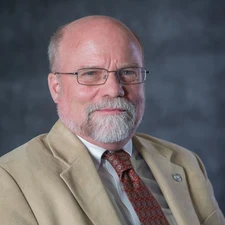John C. Eichelberger

The 2015 Sergey Soloviev Medal is awarded to John C. Eichelberger for his outstanding contribution to basic knowledge of natural hazards, in particular, of volcano eruptions and associated phenomena, as well as to reliable multidisciplinary risk assessment leading to disaster mitigation.
John C. Eichelberger is one of the most outstanding volcanologists, with knowledge spanning from magma genesis to volcano dynamics and to volcanic hazard and risk. His scientific activity and career demonstrate how a lucid understanding of the processes at the basis of magma and volcano dynamics can be vividly translated into critical contributions in the evaluation of natural hazards. Eichelberger is one of the genuine visionaries in the field of geosciences, and his contributions to the understanding of volcanic and magmatic processes have been spectacular and long-lasting. Several of his papers are amongst a small number of the most influential works of the past half century. These include his Nature papers on magma mixing and the role of permeability in eruption of silicic magmas. These are among classic works that offered elegant and inspirational answers to fundamental questions concerning eruption triggers and eruptive behaviour. Importantly, they indicated new approaches to the interpretation of volcanic rocks in addition to monitoring data, and have stimulated a great deal of further research by other scientists. In addition, he is internationally recognised for his work in two other domains: scientific drilling and Arctic geosciences.
Eichelberger has led a very distinguished career. Following studies at MIT and Stanford, he was on the staff at Los Alamos and Sandia National Laboratories before being appointed Professor of Volcanology at the University of Alaska Fairbanks (UAF). After completion of his work as Coordinator of the Volcano Hazards Program at the US Geological Survey, he returned to UAF to become a Dean of Graduate School.
He has been directing an international community of geoscientists to gain and apply the scientific knowledge needed to mitigate the consequences of natural hazards. His efforts to centre the scientific community’s attention on acquiring the knowledge needed to diminish the impact of natural hazards are exemplified by his founding of the JKASP (Japan-Kamchatka-Alaska Subduction Processes) programme. He has been the inspirer and co-organiser of the Volcano Observatory Best Practice workshop series, which for the first time ever gathered representatives of tens of volcano observatories worldwide to discuss protocols and practices in volcanic hazard evaluation and estimate, and define shared best practices in hazard communication between scientists and the civil society. Most recently he initiated a programme on natural hazards between the US and Russia. His engagement with Russian colleagues in Kamchatka and organisation of international summer field schools both there and in Alaska (with now hundreds of alumni) represent major achievements in science diplomacy and volcanological training. His contributions to understand and quantify volcanic hazard, especially in – but not restricted to – Alaska and Kamchatka, continue to inspire generations of volcanologists.
